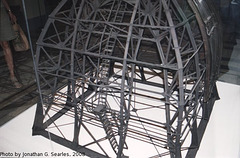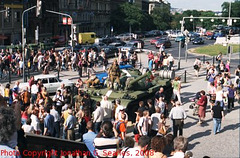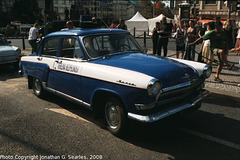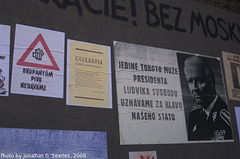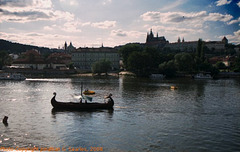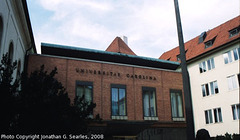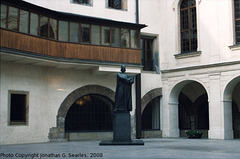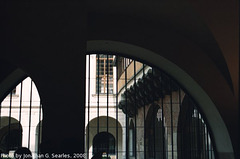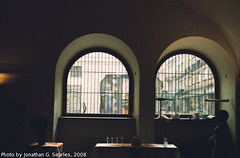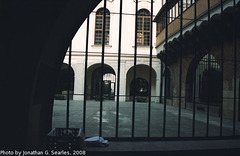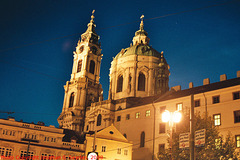
Prague Without The Trains or the Cameraphone
This is an album for those of you exasperated with the number of train, tram, and general rail photos I have. :-) This is the "quality" Prague album, at least to people who hate trains. :-)
Narodni Muzeum Model, Prague, CZ, 2008
| |
|
Several of the museum's normal exhibits remained open for the 1968 exhibition, including a series of models of the museum itself, which is indeed an impressive building. This model depicts to the frame and interior for part of the roof.
Narodni Muzeum Model, Picture 3, Prague, CZ, 2008
Crowd Outside of '68 Exhibit, Prague, CZ, 2008
| |
|
Outside of the museum, they had a number of larger temporary exhibits of what would have been seen on the streets in 1968. One of the most iconic of the artifacts from that time was this Russian T-54 main battle tank, in the center, as well as a 1960's-era Skoda 1000MB saloon (on the left behind the tank), and a 1960's-era Volga police cruiser (directly behind the tank).
Preserved T-54 Tank, Picture 2, Prague, CZ, 2008
| |
|
Here's a closer view of the tank. The ventilator on top of the turret, to the left of the reenactor, is the main spotting feature of a T-54, as opposed to T-55, tank, at least according to Wikipedia (I don't have a copy of Jane's).
Volga Police Car, Prague, CZ, 2008
| |
|
This is a 1960's-era (I don't know the exact year) Czech police car, although it's a GAZ-21 Volga, a Russian-made car. Contrary to popular belief, Volga buses and trucks are still made today (cars were made until 2007), but that's another story. The most interesting thing about this car for a Westerner isn't its Russian manufacture, necessarily, but that it doesn't say "policie" on it, the Czech word for police. In the Czechoslovak Socialist Republic, calling a police officer was considered politically incorrect (If I'm not mistaken, some people were jailed for calling the police the police.). In a Communist regime, the police, an instrument of capitalist repression, were said not to exist. Instead, there was the "Verejna Bezpecnost Sluzby," (I think I spelled that right, but correct me if I didn't) or the "Public Security Service." Police officers weren't police officers, but "security officers," and so on. Later Verejna Bezpecnost cars (usually Skodas) in the 1980's were repainted into a white paint scheme with yellow fenders that was only marked with the large letters "VB," on the doors, and the car number on the roof. The car that you can see behind this Volga is a Skoda 1000MB, which was the standard Communist-endorsed people's car of Czechoslovakia in the late 1960's.
Volga Police Car, Picture 2, Prague, CZ, 2008
| |
|
Here's a rear view of the Volga. The tailfins are somewhat notable, as the Communists seemed to have no problem with them in spite of their being a very American feature. Tatras (from Czechoslovakia) also had them, as did Chaikas (from Russia).
Repro Grafitti at '68 Exhibit, Prague, CZ, 2008
| |
|
Although grafitti was much rarer in the Czechoslovak Socialist Republic than in the modern Czech Republic (for that matter, it was rarer everywhere in Europe in the 1960's than it is today), during the brief protests of 1968 the Czechs used it aggressively to insult the Russians or to voice their grievances. Many posters were also put up, in spite of Communist efforts to restrict access to printing presses and copiers.
Repro '68 Protest Posters, Prague, CZ, 2008
| |
|
The Czechs are rarely vicious in their criticism of even their most hated enemies, however. Most of the posters were either imploring the Russians to better serve the cause of socialism by going home, while others, like the one on the far left here, simply joked around, saying in this case "We don't give beer to occupiers."
Repro '68 Protest Posters, Picture 2, Prague, CZ,…
Repro '68 Protest Posters, Picture 3, Prague, CZ,…
Longboat on the Vltava, Prague, CZ, 2008
| |
|
I got this shot more or less randomly, when I noticed this replica Viking longboat in the Vltava. I'm not sure what the inspiration for the boat was. I'm assuming it's just an attempt at getting attention. In the background, incidentally, you can see Miklasky Chram on the left, and Prazky Hrad, the Prague Castle, on the right.
Karolinium Entrance, Prague, CZ, 2008
| |
|
The Karolinium is the oldest complex of buildings in the possession of Universita Karlova (Charles University). I've been unable to get a date of construction, but one website says that one window dates to 1370, and the complex was at least conceived in the late 1360's, after Charles College required dedicated facilities. During its long history, the Karolinium has hosted most of the universities more famous professors and students, including Jan Hus. Today the Karolinium hosts many activities, including graduations.
Karolinium, Prague, CZ, 2008
| |
|
I'm not clear on whether this statue is of Jan Hus, or somebody else. Does anybody know?
Karolinium Interior, Picture 3, Prague, CZ, 2008
| |
|
This is another shot out into the courtyard for further back in the room. I took this during UJOP graduation.
Karolinium Interior, Picture 4, Prague, CZ, 2008
Karolinium Interior, Picture 5, Prague, CZ, 2008
Miklasky Chram, Prague, CZ, 2008
| |
|
This shot was easier than the tram shot, and was taken a few minutes later. I think that this may be my best nightshot yet of Miklasky Chram, as interference from the streetlights limited past attempts.
Palac Adria Front, Prague, CZ, 2008
| |
|
Palac Adria aroused some controversy immediately post-1989 during privatisation of Prague's real-estate, when there was talk of selling it to a detergent company (or so the plan went, anyway, I know little about what ultimately happened). Vaclav Havel, who was president at the time, caught most of the flak, as he supported the sale, on the basis that a successful business could invest more money in its restoration than the government could. Critics thought it inappropriate to privatise a property of Palac Adria's architecural and historic significance, if god forbid it could be torn down or arsoned. For more on this, see the documentary film about Vaclav Havel "Obcan Havel," a.k.a. "Citizen Havel." In the end, it survived, and is today a successful office building, theatre, and coffeehouse, as seen here. Built in 1922-1925, and designed by Jakub Potucek, Palac Adria is considered a prime example of rondo-cubist architecture. It was originally supposed to be for an Italian insurance company, so there are a lot of interesting mosaics inside depicting the different types of insurance on offer.
Jump to top
RSS feed- Latest items - Subscribe to the latest items added to this album
- ipernity © 2007-2024
- Help & Contact
|
Club news
|
About ipernity
|
History |
ipernity Club & Prices |
Guide of good conduct
Donate | Group guidelines | Privacy policy | Terms of use | Statutes | In memoria -
Facebook
Twitter

